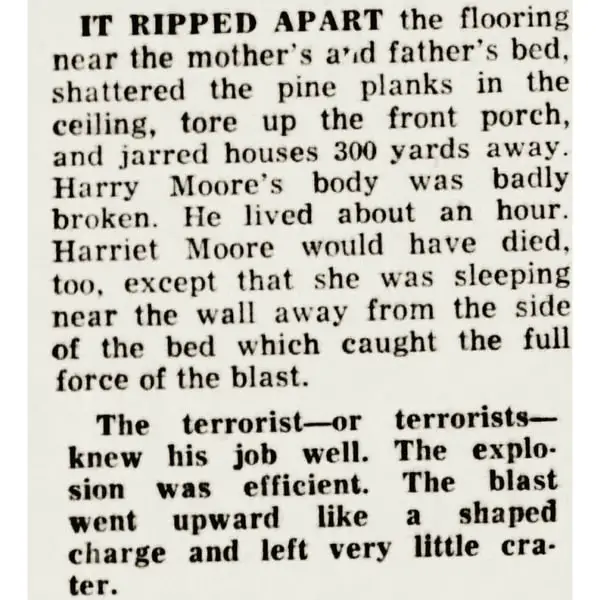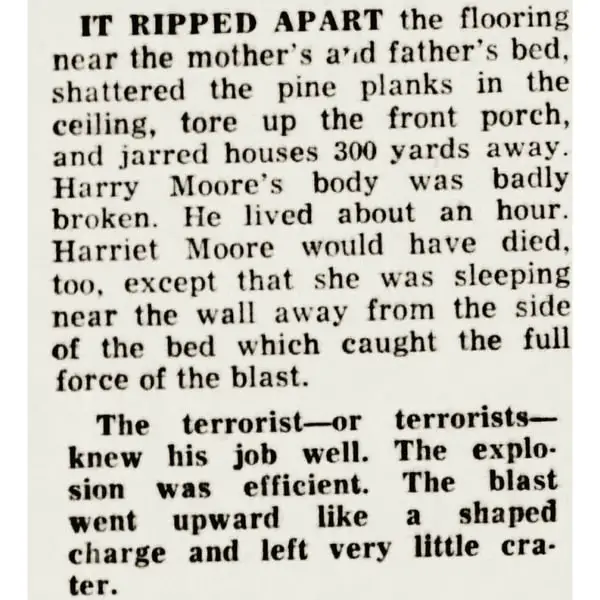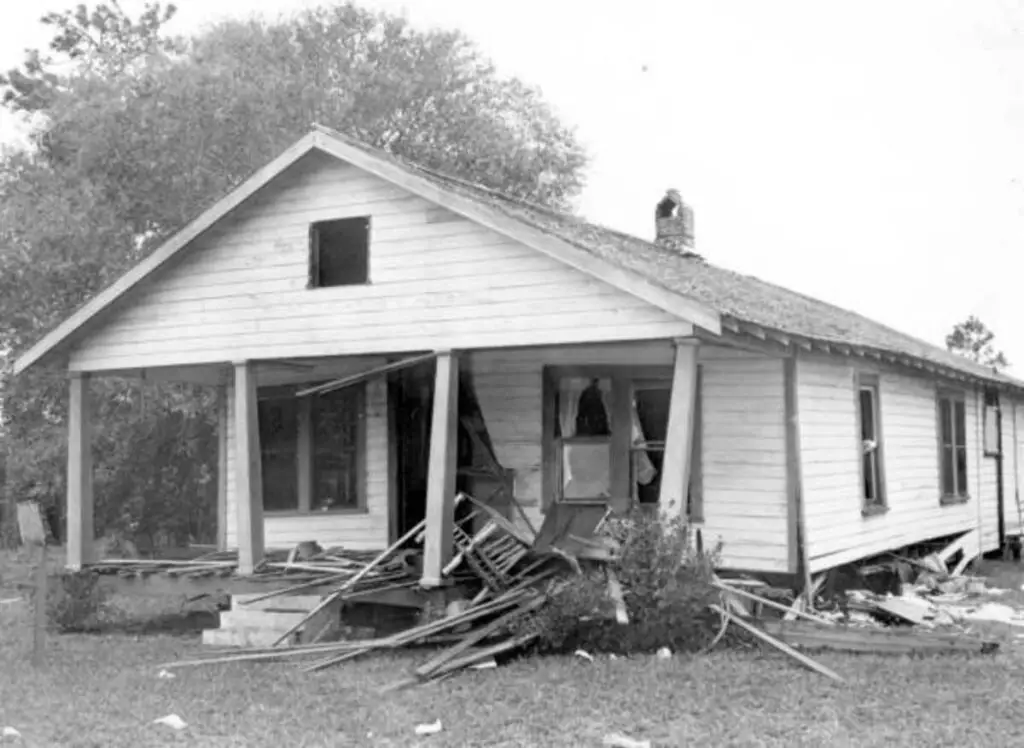863
MIMS, Fla. — About 45 miles northeast of Orlando is Mims, a small community in Brevard County along the Atlantic coast. Standing tall within the town is the water tower that reads, “WELCOME TO MIMS THE FRIENDLY TOWN.” But there was a time when Mims was more deadly than friendly.
Harry Tyson Moore was born on Nov. 18, 1905, in Houston, Fla., to Johnny and Rosa Moore. His father died when he was nine, leaving Rosa Moore a single mother. Unfortunately, she struggled to raise him alone and sent the boy to live with his three aunts in Jacksonville.
“By 1900, Jacksonville emerged as Florida’s largest city with 57 percent of its population African-Americans working in the city’s booming hotel, lumber, port, construction, and railroad industries,” writes Ennis Davis for The Palm Beach Post.
For Rosa Moore, it was the ideal place for her son to live and make something of himself.
Moore graduated high school, began teaching at a Cocoa black elementary school, and later became the principal at the Titusville Colored School. Moore met his future wife, Harriette Vyda Simms, at a party. Simms was a former teacher who was selling life insurance. She was born in West Palm Beach on June 19, 1902, to David and Annie Simms.
After the Moores married, they finished their college education and graduated from Bethune Cookman College in Daytona Beach.
The couple had two daughters, Annie Rosalea “Peaches” Moore, born in 1928, and Juanita Evangeline Moore, in 1930. Moore built a modest one-story bungalow for his family in Mims.
Over the following years, the Moores became civil rights activists and formed the Brevard County NAACP in 1934. Moore served as NAACP’s first statewide executive secretary. He fought against mob lynchings and police brutality and helped thousands of blacks to vote in primary elections.
“He first became involved in anti-lynching efforts after three white men kidnapped 15-year-old Willie James Howard, bound him with ropes and drowned him in a river for the “crime” of passing a note to a white girl in 1944,” writes Francine Uenuma in Smithsonian Magazine.
The men were never tried or convicted for Willie’s murder, which fueled Moore’s fight. According to Uenuma, he wrote a letter to Florida’s congressional delegation in 1947.
“We cannot afford to wait until the several states get ‘trained’ or ‘educated’ to the point where they can take effective action in such cases. Human life is too valuable for more experimenting of this kind. The Federal Government must be empowered to take the necessary action for the protection of its citizens.”
In 1949, Moore became involved in the Groveland Four incident after uncovering evidence the men had been beaten. According to PBS, “Moore leveled those charges against the most notorious lawman in the country: Sheriff Willis McCall of Lake County.”
Norma Padgett, 17, white and married, wrongfully accused four black men of raping her. Padgett claimed she and her husband were driving home from a dance when their car stalled. The four men allegedly pulled her out of the car at gunpoint, attacked her husband, then abducted and raped her.
However, a taxi driver who gave her a ride after the rape allegedly occurred said she did not seem upset or mention she had been raped. She only mentioned the rape story after speaking with her husband, William Padgett. According to newspaper articles, it was more likely that her husband gave her a beating and concocted the wild rape story so Padgett’s parents would not see the bruises her husband left.
Padgett’s accusations “set off a manhunt that spurred an onslaught of violence against Black residents of Groveland, near Orlando, mobilizing the National Guard and prompting Thurgood Marshall, then a lead attorney for the NAACP, to take up the cause of the men who would come to be known as the Groveland Four,” writes Erik Ortiz for NBC.
In July 1949, Lake County Sheriff Willis McCall formed a mob of hundreds of white men, and they tracked one of the suspects, Ernest Thomas, to a swamp, shooting him more than 400 times as he slept.
An all-white jury convicted the other three men in April 1951. Two received death sentences in April 1951; however, the U.S. Supreme Court overturned the death sentences, and Lake County prosecutors were preparing to try the men again.
On Nov. 6, 1951, Lake County Sheriff Willis McCall was transporting Walter Irvin and Sammy Shepherd to a pretrial hearing. McCall claimed the handcuffed suspects attacked him. He then shot both men, killing Shepherd and critically wounding Irvin.
Moore wrote repeatedly to Governor Fuller Warren, methodically dismantling McCall’s claims. He admonished Warren that “Florida is on trial before the rest of the world,” calling on him to remove the officers involved in the shooting. He closed with a reminder that “Florida Negro citizens are still mindful of the fact that our votes proved to be your margin of victory in the [runoff election in] 1948. We seek no special favors; but certainly we have a right to expect justice and equal protection of the laws even for the humblest Negro. Shall we be disappointed again?”
Francine Uenema, Smithsonian Magazine.
Just weeks after Moore challenged McCall, the Moores were dead.
Christmas Day 1951 was a happy day for the Moores; they celebrated their 25th wedding anniversary and the holiday with their loved ones.
The Moores, including Annie Moore, 24, and Rosa Moore, 71, had dinner with Harriette Moore’s brothers and returned home about 7:15 p.m. Annie Moore was on break from her teaching job in Ocala; Evangeline Moore was headed home from Washington, D.C. on a train.
The family settled in for the night. Unopened Christmas presents lay in the corner of the living room. Annie Moore stayed in a back bedroom while her grandmother occupied an adjoining room off her parents’ front bedroom. At 10:10 p.m., Annie turned off the light to go to sleep.
Rosa Moore had not yet fallen into slumber when she noticed an overhead light fixture drop to the floor. Next came a deafening roar.
At 10:20 p.m., a bomb exploded, tearing through the home and critically injuring Moore and his wife.
Annie Moore and Rosa Moore were not injured in the attack. Annie later said she heard two distinct blasts.
Both women rushed to the Moores in the front bedroom. Rosa Moore found her son unconscious and buried in the rubble in the bedroom, while Harriette Moore was pinned under a bookcase near her husband. The two women pulled Harriette Moore out from under the case. She was conscious and tried unsuccessfully to remove her husband from the rubble.
Annie Moore raced to the telephone and called her uncles, Arnold and George Simms, who ran over, dug Moore out from the rubble, and transported the Moores to Sanford Hospital. Moore died about an hour after the blast. His wife suffered a concussion and internal injuries.
Meanwhile, Evangeline Moore arrived at the train station with other relatives waiting for her instead of her parents. She immediately knew something terrible had happened and rushed to the hospital.
Shortly after the explosion, Deputy Sheriff Giles Platt used a bloodhound named Colonel Evans to track footprints in the orange grove near the crime scene to 100 yards from the Dixie Highway, the Orlando Sentinel reported. However, the dog lost the scent.
FBI agents made casts of the footprints, which showed a long stride and a size eight shoe. They also examined Moore’s vehicle, which had not been wired with a bomb. Cement blocks elevated the home about two feet, making it easier to attach a bomb directly underneath Moore’s bedroom window.
The bombing investigation lasted about a year, with no arrests.
News of the horrific bombing made national headlines, and former first lady Eleanor Roosevelt released a statement on Dec. 28, 1951.
“I grieve for this dead man and his widow, who were trying to do the right thing as they saw it for their people who are citizens of the United States. Whether you agree with what they did or not, they should have been protected against any violence of this kind,” she wrote.
Harriette Moore, 49, died at Sanford Hospital on Jan. 3, 1952. With her children grown, she was ready to join her husband.
The NAACP held a fundraising gala in March 1952 in New York City and featured Langston Hughes’ poem, “Ballad of Harry Moore,” later adapted into a song by Sweet Honey in the Rock.
The Moore bombing remains unsolved, but most people believe it was the work of the KKK after a member in nearby Orlando committed suicide one day after authorities questioned him.
Meanwhile, the Moore sisters had to live without their parents for the rest of their lives.
Per The Washington Post:
“As a gesture of family strength, Evangeline and her sister, Annie, agreed that they would never betray any outward sign of grief, and they rarely spoke of their parents’ deaths.”
Annie Moore Hampton died on Aug. 30, 1972, at age 44, followed by her husband, Leonard Hampton, 11 months later. Evangeline Moore died in 2015 at age 85. She became a civil rights activist after the killing of her parents.
During Charlie Crist’s run for Florida governor in 2006, he announced that his office had “resolved the Moore bombing, placing the blame on four long-dead Klansmen,” writes Matt Schudel in The Washington Post. However, investigators said Crist’s office had no new evidence, and the case remains unsolved.
Six years later, as governor of Florida, Crist relaunched the investigation into Willis’ role in several racially motivated murders in Central Florida, including the Moore bombing.
In 2019, Governor Ron DeSantis granted posthumous pardons to the Groveland Four. Padgett spoke for the first time about her alleged rape in 2015 in front of DeSantis. She stuck to her story that the four men had raped her and opposed the pardons. However, her statement was more of a cold and emotionless ramble. Nevertheless, the Shepherd family says Padgett showed up at their home and told Shepherd’s brother the rape never happened.
In November 2021, decades after their convictions, a Florida judge exonerated all four men of the crime.
Today, the Moores’ legacy continues, and people will never forget them or their sacrifice.
The Moore Memorial Park and Cultural Center in Mims opened in 2004 with a replica of the Moores’ home on the original property and a museum for visitors.
The Smithsonian’s National Museum of African American History & Culture displays materials “originally located in Harry T. Moore’s briefcase and are dated from 1942 to 1949. The collection contains correspondence, memoranda, business records, ephemera, and newspaper clippings,” the website states.
Recommended reading: “Groveland Four, the Black men accused in a 1949 rape, get case dismissed,” by Erik Ortiz for NBC News, and “The Unsolved Murder of Civil Rights Activist Harry Moore,” by Francine Uenuma in Smithsonian Magazine.
True Crime Diva’s Thoughts
I decided to write about the Moores because of the recent anniversary of their deaths, and it’s a heartbreaking story that still needs to be told. For more in-depth reading, please read the above articles by Ortiz and Uenuma.
The 1951 investigators likely knew they would never arrest a white man for the crime. Even if they had evidence, an all-white jury would have found him not guilty.
I would not be surprised if McCall had something to do with the bombing, which is one of many reasons why authorities never made an arrest. It is not a coincidence that Harry Moore challenged McCall over the Groveland Four and then ended up dead. McCall likely had his KKK minions plant the bomb instead of himself. I think it’s safe to say McCall was also a KKK member.
Whoever planted the bomb must have known where the Moores’ bedroom was, or it was a lucky guess.
McCall lived to be in his 80s and was investigated dozens of times throughout his career for the mistreatment of black people in his jurisdiction. Obviously, he lied about the Groveland Four; he purposely shot Irvin and Shepherd. I would wager that the mob of white men who killed Thomas wore white masks and robes. He was just a vile man.
Every time I read stories like the Moores, it angers me because they were killed speaking up for something they believed in and had the guts to go up against white men. And women like Padgett… I wish I could go back in time and beat the shit out of them. Sorry, not sorry. That’s the least of what they deserved. Many white women falsely accused black men of rape, and those men paid a high price for their stupid lies.































